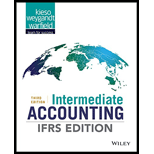
Bond: A bond is a debt instrument, which repaid along with a specific rate of interest on maturity. The governments or the corporations issue this form of debt security for raising capital.
(a)
To discuss: To discuss the conceptual merits of each the
(b)
To determine the reason for investors to pay $1,085,800 for bonds that has a maturity value of just $1,000,000.
(c)
(1) To discuss: To discuss the conceptual merits for the coupon or nominal rate.
(2)
To discuss: To discuss the conceptual merits for the effective or yield rate at the date of issue.
(d)
To determine whether
Trending nowThis is a popular solution!

Chapter 14 Solutions
Intermediate Accounting: IFRS Edition
- Calculate the labor quantity variance?? Accountingarrow_forwardNonearrow_forwardTechnoWorks has an expected EBIT of $50,000 in perpetuity and a tax rate of 30 percent. The firm has $100,000 in outstanding debt at an interest rate of 8 percent, and its unlevered cost of capital is 12 percent. What is the value of the firm according to M&M Proposition I with taxes? Should TechnoWorks change its debt-equity ratio if the goal is to maximize the value of the firm?arrow_forward
- I need assistance with this general accounting question using appropriate principles.arrow_forwardTowson Manufacturing had a Work in Process balance of $138,000 on January 1, 2018. The year-end balance of Work in Process was $56,000 and the Cost of Goods Manufactured was $610,000. Use this information to determine the total manufacturing costs incurred during the fiscal year 2018. (Round the answer as whole dollars only.)arrow_forwardPlease give me correct answer this financial accounting questionarrow_forward
- Elena gives stock to Jake that has a tax basis of $4,500. At the time of the gift, the stock is worth only $3,800. Jake later sells the stock for $5,000. What amount of gain must Jake report on the sale?arrow_forwardWhat is the polka electronics contribution margin for November??arrow_forwardWhat is a fair price per share, and how many additional shares must Sin sell to the angle investor?arrow_forward

 AccountingAccountingISBN:9781337272094Author:WARREN, Carl S., Reeve, James M., Duchac, Jonathan E.Publisher:Cengage Learning,
AccountingAccountingISBN:9781337272094Author:WARREN, Carl S., Reeve, James M., Duchac, Jonathan E.Publisher:Cengage Learning, Accounting Information SystemsAccountingISBN:9781337619202Author:Hall, James A.Publisher:Cengage Learning,
Accounting Information SystemsAccountingISBN:9781337619202Author:Hall, James A.Publisher:Cengage Learning, Horngren's Cost Accounting: A Managerial Emphasis...AccountingISBN:9780134475585Author:Srikant M. Datar, Madhav V. RajanPublisher:PEARSON
Horngren's Cost Accounting: A Managerial Emphasis...AccountingISBN:9780134475585Author:Srikant M. Datar, Madhav V. RajanPublisher:PEARSON Intermediate AccountingAccountingISBN:9781259722660Author:J. David Spiceland, Mark W. Nelson, Wayne M ThomasPublisher:McGraw-Hill Education
Intermediate AccountingAccountingISBN:9781259722660Author:J. David Spiceland, Mark W. Nelson, Wayne M ThomasPublisher:McGraw-Hill Education Financial and Managerial AccountingAccountingISBN:9781259726705Author:John J Wild, Ken W. Shaw, Barbara Chiappetta Fundamental Accounting PrinciplesPublisher:McGraw-Hill Education
Financial and Managerial AccountingAccountingISBN:9781259726705Author:John J Wild, Ken W. Shaw, Barbara Chiappetta Fundamental Accounting PrinciplesPublisher:McGraw-Hill Education





